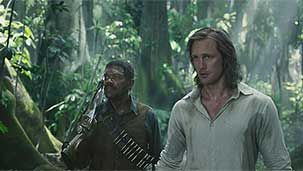I see what you were going for here; a high volume of tightly framed shots to urge the audience to tap into our dormant, primal selves, employing a womb-like closeness, hoping to showcase the animalistic savagery that hides deep inside all humans. The concept invited intimacy and could have been really impactful if used sparingly, instead it only highlighted The Legend of Tarzan’s shoddy editing and its humdrum lead, Alexander Skarsgård.
Contrary to what many attendees of Legend of Tarzan believed (judging by the amount of kids in the audience), the movie is not a sequel to the 1999 Disney animated classic. The _Legend of Tarzan is actually an original story of sorts, grabbing inspiration from the ‘Tarzan of the Apes’ series by Edgar Rice Burroughs.
It follows Tarzan – now known as John Clayton or Lord Greystoke – as he hesitantly agrees to head back to the jungles of the Congo after years of living in London as a civilized gentleman. He believes he is there to act as an ambassador for Britain when he is actually walking into a trap set by the villainous Leon Rom, who wants to establish slavery in order to mine precious diamonds. Once he arrives at the Congo, Tarzan is ambushed by Rom and forced to watch his wife, Jane, be taken captive. In order to get her back, he must ditch his pressed pantaloons and become, once again, the King of the Apes.
It makes total sense why you chose to favour the extreme close-up. After spending so many years being civilized, Tarzan struggles to go back to the man he once was. Your too-close-for-comfort cinematography was meant to capture his feral nature clawing to get out.
Unfortunately, Alexander Skarsgård’s monotonous energy drained any level of excitement from the experience, even when he was parading as some strange jungle Batman, attacking people from the shadows and fighting off hordes of colonial military men in close quarters. Given that he was cast to literally play the King of the Apes, it's a shame that Skarsgård couldn't emote any sort of fervour other than tight-lipped smouldering. It seems he was more concerned with flexing his abs than he was with being Tarzan. He was less man raised by apes and more Abercrombie model with mud smeared on his face.
But he looks good without a shirt on, which is probably the only reason he got the job in the first place. He was a highly mismatched beauty to your beastly filming concept.
But we can’t blame Skarsgård for everything. Your up close and personal approach took its biggest hit during the editing process. The extreme close-ups were interspersed between panning shots, action sequences, and flashbacks without any outward reasoning. There didn't seem to be any method behind the madness.
Your techniques should've been used sparingly to show the true nature of, well, nature. Instead your tight frames were implemented over and over until all that was left was a movie with a lack of identity, which is ironic because The Legend of Tarzan is all about identity.
The Legend of Tarzan had all the elements to be a great movie; a classic character returning to glory to stop an evil tyrant bent on using slavery to get his way, a strong message of staying true to one's self and never forgetting where you came from, and excellent performances by Samuel L. Jackson and Christoph Waltz. It even had your tight frame concept that would have done wonders if used properly.
Sadly, the concept was tied to a stone-faced lead and an editing process that had its own aspirations which left The Legend of Tarzan incapable of seeing the forest for the trees.
Sincerely,

Ankit







